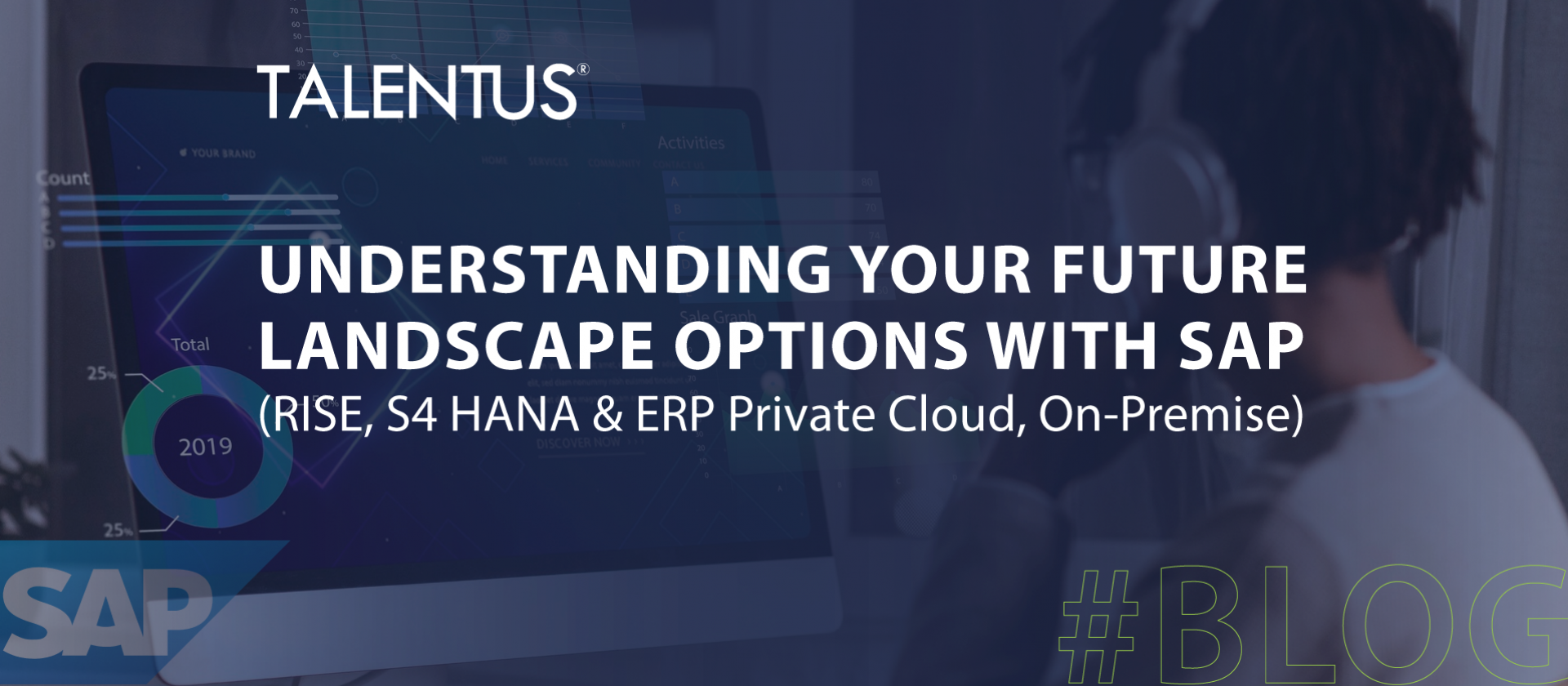Understanding Your Future Landscape Options with SAP (RISE, S4 HANA & ERP Private Cloud, On-Premise) – By Gerardo Banegas
Choosing the right SAP landscape for your business can feel like navigating a maze. With terms like RISE with SAP, SAP S/4HANA Private Cloud Edition, and On-Premise floating around, it’s easy to get confused. But don’t worry! We’re here to break down these options in plain language so you can make the best decision for your organization’s future.
Think of your SAP landscape as the environment where your SAP software lives and runs. Just like you have different options for where you live (an apartment, a private house, etc.), you have different options for your SAP system. Let’s explore the main ones:
1. RISE with SAP: The “Everything-as-a-Service” Approach
Imagine moving into a fully furnished, serviced apartment. That’s kind of what RISE with SAP offers. It’s SAP’s comprehensive “business transformation as a service” offering.
- What it is: RISE with SAP bundles together SAP S/4HANA Cloud, various SAP Business Technology Platform (BTP) services, and infrastructure management into a single contract managed by SAP or one of their partners.
- Think of it as: A managed service where SAP takes care of the technical complexities, allowing you to focus on your core business. Not everything is included and managed; you still need a local Basis administrator, Functional senior Key Users or Consultants and ABAPs for custom developments. Please read the small letters of the contract, the devil is in the details.
Key benefits:
- Simplified management: SAP handles the infrastructure, technical upgrades, and maintenance.
- Faster time to value: Pre-packaged solutions and guided implementation can speed up your deployment.
- Scalability and flexibility: Easily adjust resources as your business needs change.
- Innovation focus: Access to the latest SAP innovations and BTP services.
- Good for: Companies looking for a streamlined approach to adopting SAP S/4HANA in the cloud with reduced IT overhead. It’s particularly attractive for those who want to offload infrastructure management and focus on business outcomes.
2. SAP S/4HANA Private Cloud Edition: Your Dedicated Cloud Space
This option is like having your own private house in a secure, managed community. You get the benefits of the cloud but with more control over your environment.
- What it is: SAP S/4HANA Private Cloud Edition is a single-tenant environment hosted in the cloud (either with SAP or a hyperscaler like AWS, Azure, or Google Cloud). It’s dedicated solely to your organization.
- Think of it as: A cloud deployment with greater flexibility and customization options compared to the multi-tenant public cloud offering within RISE.
Key benefits:
- Greater control and customization: You have more influence over the system configuration, upgrade schedules, and security settings.
- Integration flexibility: Easier to integrate with existing on-premise systems or other cloud solutions.
- Dedicated resources: Performance is consistent as you’re not sharing resources with other companies.
- Choice of infrastructure provider: You might be able to leverage existing relationships with hyperscalers.
- Good for: Organizations with complex landscapes, specific compliance requirements, or a need for greater control over their SAP environment while still benefiting from cloud infrastructure.
3. SAP S/4HANA On-Premise: The Traditional Approach
This is like owning your house outright. You have complete control, but also the full responsibility for everything.
- What it is: SAP S/4HANA On-Premise means you own and manage the entire SAP environment within your own data centers. This includes the hardware, software installation, maintenance, and upgrades.
- Think of it as: A traditional IT setup where you have full control over your SAP system.
Key benefits:
- Maximum control: You have complete authority over every aspect of your SAP landscape.
- Data sovereignty: Data resides within your own infrastructure, which can be crucial for certain regulatory requirements.
- Gradual migration: You can potentially have more control over the pace of your S/4HANA adoption.
Key considerations:
- Higher upfront investment: You’re responsible for purchasing and maintaining hardware and software.
- Significant IT overhead: Requires a dedicated IT team to manage the infrastructure, upgrades, and security.
- Slower pace of innovation: Adopting new SAP features requires manual upgrades.
- Good for: Companies with very specific security or compliance needs that mandate on-premise deployment, or those with significant existing investments in their own data center infrastructure and the expertise to manage it.
SAP S/4HANA On-Premise: Complete Control, Full Responsibility
This deployment model mirrors owning a home outright. You gain absolute control but also assume complete responsibility for all aspects of your SAP environment.
Core Definition: SAP S/4HANA On-Premise entails owning and managing your entire SAP system within your organization’s data centers. This includes managing hardware, software installation, ongoing maintenance, and necessary upgrades.
Conceptualization: Envision a traditional IT framework where your organization possesses end-to-end control over its SAP system.
Advantages:
- Unparalleled Control: Exercise complete authority over every facet of your SAP landscape.
- Data Governance: Maintain data within your own infrastructure, a critical factor for specific regulatory compliance.
- Flexible Transition: Potentially allows for greater influence over the timeline of your S/4HANA migration.
Disadvantages:
- Significant Initial Outlay: Requires substantial investment in purchasing and maintaining both hardware and software.
- Considerable IT Management: Necessitates a dedicated IT staff to handle infrastructure, upgrades, and security protocols.
- Delayed Innovation Adoption: Integrating new SAP functionalities is contingent on manual upgrade processes.
Ideal Scenario: This approach is well-suited for organizations with stringent security or compliance mandates necessitating on-site deployment. It also benefits companies with substantial pre-existing investments in their own data center infrastructure and the in-house expertise to effectively manage it.

4. SAP ERP Private Edition (For ECC customers only 2028-2033 TBA)
This is like moving from your old but reliable house (ECC) to your new house (S4 HANA) but moving to it more slowly at your pace and carefully with SAP support from 2028 to 2033. You have complete granular control over your moving (migration) to your new S4 HANA residence.
Due to the majority of SAP customers’ resistance to move to S4 HANA SAP will announce this option in mid-2025. According to Gartner’s latest research, as of the end of the fourth quarter of 2024, approximately 61% of SAP ECC customers had not yet licensed SAP S/4HANA. For ERP customers still running on ECC, SAP created this transition option,” designed to help customers transition to SAP’s cloud ERP solutions with a phased approach and support until 2033. This offering provides an SAP ERP cloud subscription centered around SAP ECC, along with dedicated services and support for the transition to S4 HANA cloud ERP, according to SAP News Center.
The “SAP ERP, private edition, transition option” aims to assist customers in moving to SAP’s cloud ERP offerings through a step-by-step process. This solution provides a cloud subscription for SAP ERP, focusing on SAP ECC, complemented by specific services and support for the cloud ERP.The “SAP ERP, private edition, transition option” is a solution designed to facilitate a gradual shift for customers toward SAP’s cloud ERP offerings. As reported by SAP News Center, this option centers on an SAP ERP cloud subscription built around SAP ECC and includes specialized services and support to aid in the transition to cloud ERP. This offering intends to guide customers through a phased migration to SAP’s cloud-based ERP solutions.
Key Features and Benefits:
Extended Support for SAP ECC:
The new offering addresses the needs of organizations still using SAP ECC, providing support for security, legal, and software issues, particularly as mainstream maintenance for ECC 6.0 ends in 2027.
Phased Cloud Transformation:
It offers a bridge for organizations with complex landscapes that may need more time to fully migrate to S/4HANA.
Non-Mandatory Offering:
This offering is designed to be an additional, optional solution for customers who need extra time and support for their cloud transformation journey, rather than a mandatory requirement, according to SAP News Center.
Availability and Usage:
The offering will be available for purchase in 2028 and active for use from 2031-2033.
Focus on SAP ECC:
The scope of the offering is centered around SAP ECC, not the full scope of SAP Business Suite 7, which is only available for subscription until the end of 2030.
Dedicated Services and Support:
The offering includes a set of dedicated services to assist with the transformation process, ensuring a smooth transition to cloud ERP, according to SAP News Center.
The “SAP ERP, private edition, transition option” offers SAP ECC customers a way to move to SAP’s cloud ERP at their own pace with detailed control over the migration. Created due to many customers being hesitant to move directly to S4 HANA (with around 61% still on ECC), this option provides a phased approach with support extending until 2033. It’s a subscription-based cloud ERP centered on SAP ECC, including dedicated services and support for the cloud transition. This aims to guide customers through a step-by-step migration to cloud-based ERP solutions.
Key Aspects and Advantages:
- Sustained Support for SAP ECC: Recognizing the continued use of SAP ECC, this provides necessary support for security, legal, and software matters, especially with mainstream maintenance for ECC 6.0 ending in 2027.
- Gradual Cloud Transition: It acts as a stepping stone for organizations with complex systems that might need more time before a full S/4HANA migration.
- Voluntary Choice: This is presented as an extra, optional solution for customers needing more time and assistance with their cloud transformation, not a compulsory move.
- Availability Timeline: Customers can purchase this offering starting in 2028, with active use spanning from 2031 to 2033.
- Focus on SAP ECC: The offering’s scope is specifically around SAP ECC, not the broader SAP Business Suite 7, which is only available for subscription until the end of 2030.
- Specialized Assistance: Included are dedicated services designed to support the transformation process, ensuring a smoother transition to cloud ERP.
Which Option is Right for You?
The best SAP landscape option depends on your unique business needs, IT strategy, resources, and long-term goals. Consider factors like:
- Budget: Cloud solutions often have lower upfront costs but ongoing subscription fees. On-premise requires significant capital expenditure but potentially lower long-term operating costs (though this is often debated).
- IT capabilities: Do you have the in-house expertise to manage an on-premise environment, or would a managed cloud service be more suitable in which you still need in-house support?
- Scalability needs: How quickly do you anticipate your business growing, and how easily can the chosen landscape scale to accommodate that growth?
- Integration requirements: How complex is your existing IT landscape, with legacy systems integrations?
- Security and compliance: What are your industry-specific security and compliance requirements?
Previous blog: Understanding SAP Digital Access Licensing: What It Means for Integrations with Legacy Systems
In Conclusion
Understanding the differences between RISE with SAP, SAP S/4HANA, ERP Private Cloud Edition and On-Premise is the first step towards choosing the right path for your SAP S/4HANA journey. Each option offers a unique set of benefits and considerations. By carefully evaluating your organization’s needs and priorities, you can select the landscape that will best support your business growth and innovation. Please reach Talentus Global we can help you take the right decision with your SAP future landscape.
We are Talentus: a global company that provides US companies with reliable IT services, near-shore talent, and SAP support to meet their needs.


